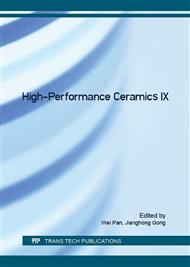p.169
p.173
p.178
p.182
p.188
p.193
p.198
p.203
p.207
Effect of Sintering Pressure on Mechanical Properties of BN-Si3N4 Ceramic Composites Prepared by Spark Plasma Sintering
Abstract:
BN-Si3N4 composite ceramic wave-transparent materials with excellent mechanical properties were prepared by spark plasma sintering (SPS) using h-BN and α-Si3N4 powders as raw materials, Al2O3 and Y2O3 as sintering aids. The influence of sintering pressure on density and mechanical properties of BN-Si3N4 composite ceramics were studied. The phases were observed by X-ray diffraction (XRD), and the microstructures were identified by scanning electron microscopy (SEM). The results showed that with the sintering pressure increases, the relative density, bending strength and fracture toughness of the composite ceramics were significantly increased, and the porosity decreased rapidly. The effects of pressure on the properties of the composite ceramics was not significant at >40MPa, so 40MPa is optimal for the composite ceramics to gain good overall performance, i.e. the relative density was 89.1%, the porosity was 2.3%, the bending strength reached 215.4 MPa, and the fracture toughness was 3.1/MPa·m1/2.
Info:
Periodical:
Pages:
188-192
Citation:
Online since:
July 2016
Authors:
Price:
Сopyright:
© 2016 Trans Tech Publications Ltd. All Rights Reserved
Share:
Citation:


